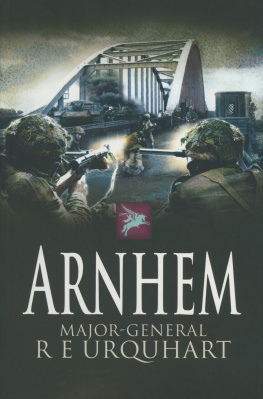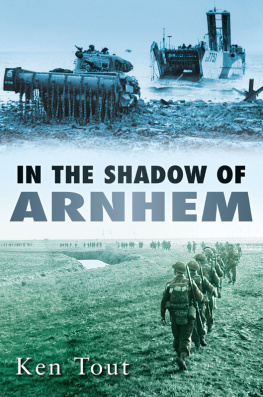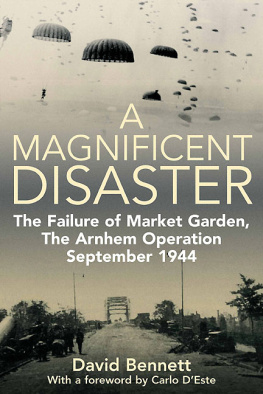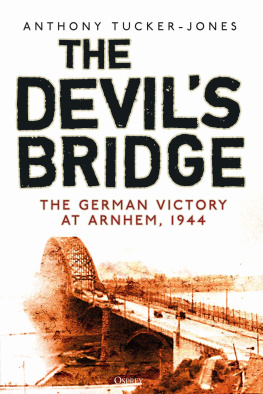THE DEVILS BIRTHDAY
By the same author
The Green Howards (Famous Regiments)
The Kandyan Wars
Men at Arnhem (first published under Tom Angus)
Suez: The Double War (with Roy Fullick)
The Book of Campden
Plumer: The Soldiers General
The History of the Green Howards: 300 Years of Service
THE DEVILS
BIRTHDAY
The Bridges to Arnhem, 1944
Geoffrey Powell
Foreword by
General Sir John Hackett,
GCB, CBE, DSO, MC, MA, BLitt., LLD, DL
First published in Great Britain in 1984 by
Buchan & Enright, Publishers, Ltd
Revised edition published in 1992 by
LEO COOPER
Reprinted in this format in 2012 by
Pen & Sword Military
an imprint of
Pen & Sword Books Ltd
47 Church Street
Barnsley
South Yorkshire S70 2AS
Copyright Geoffrey Powell, 1984, 1992, 2012
ISBN 978 1 84884 627 2
The right of Geoffrey Powell to be identified as author
of this work has been asserted by him in accordance
with the Copyright, Designs and Patents Act 1988
A CIP catalogue record for this book is available from the British Library
All rights reserved. No part ofthis book may be reproduced or transmitted
in any form or by any means, electronic or mechanical including
photocopying, recording or by any information storage and retrieval
system, without permission from the Publisher in writing.
Printed and bound in England
by CPI
Pen & Sword Books Ltd incorporates the inlprints of
Pen & Sword Aviation, Pen & Sword Maritime,
Pen & Sword Military, Pen & Sword Family History,
Wharncliffe Local History, Wharncliffe True Crime,
Wharncliffe Transport, Pen & Sword Discovery, Pen & Sword Select,
Pen & Sword Military Classics, Leo Cooper, RememberWhen,
The Praetorian Press, Seaforth Publishing and Frontline Publishing
For a complete list of Pen & Sword titles please contact
PEN & SWORD BOOKS LIMITED
47 Church Street, Barnsley, South Yorkshire, S70 2AS, England
E-mail: enquiries@pen-and-sword.co.uk
Website: www.pen-and-sword.co.uk
CONTENTS
ILLUSTRATIONS
Maj -Gen Maxwell D. Taylor (Imperial War Museum*)
Brig-Gen Jim Gavin (US Department of the Army*)
Divisional staff of US 82nd Division before jumping (US DoA*)
Gheel, Belgium, as 101st Division flies over (IWM*)
Brig Gerald Lathbury (IWM*)
Brig Pip Hicks (IWM)
The first gliders to land on the LZ near Wolfheze (IWM)
The first German prisoners, 17 September (IWM)
British soldiers guarding the crossroads at Wolfheze (IWM)
Unidentified US unit dropping on 17 September(US DoA *)
A wrecked 101st Division Waco glider (Taylor Picture Library)
Generalfeldmarschall Modelhis response was swift and effective (IWM)
Germans firing at 4 Parachute Brigades drop (IWM)
Brig Shan Hacketta grossly untidy situation (IWM)
British troops on Utrechtseweg, 18 September (Adrian Groeneweg*)
The Recce Squadron in Oosterbeek on D-plus-1 (IWM*)
506th Regiment in Eidenhoven on the 18 th (US DoA*)
XXX Corps armour and transport in Eindhoven, 20 September (IWM)
The disastrous Polish glider landing, 19 September (Jasper Booty)
British dead outside Arnhem (Adrian Groeneweg*)
Model, Bittrich and Harmelthe men who defeated Market Garden (IWM)
Arnhem highway bridge before the battle (IWM)
The north end of Arnhem bridge after the failed German counter-attack (IWM)
The bridge after its recapture (IWM)
Dutch civilians evacuating St Elizabeth Hospital, Arnhem (Adrian Groeneweg*)
British dead near the Municipal Museum (Adrian Groeneweg*)
German soldiers attacking near the Museum (Adrian Groeneweg*)
A badly wounded 82nd Division soldier in Nijmegen (US DoA*)
Maj-Gen Stanislaw Sosabowski, commanding 1 Polish Parachute Brigade (Associated Press)
Shattered hopesair re-supply to 1st Airborne (IWM)
Supplies that did reach the perimeter (IWM)
6-pounder anti-tank gun in action in the perimeter (IWM)
One of the 75-mm air-transportable howitzers in action (IWM)
British troops at the Hartenstein Hotel, 23 September (IWM)
A wounded paratroop in the perimeter (IWM)
British prisoners taken during the fighting (Taylor Picture Library)
* Illustrations marked with an asterisk were kindly supplied by Drs Adrian Groeneweg of Oosterbeek
MAPS
Drawn by Neil Hyslop
We have no regrets
Major-General R.E. Urquhart, CB, DSO
The concluding words of his official
report on Operation Market
by General Sir John Hackett, GCB, CBE, DSO, MC, DL
A striking phenomenon in military commentary in our time upon World War II, high in volume and still rising, has been the attention given to Operation Market Garden. What we loosely call in Britain the battle of Arnhem and in the Netherlands they refer to as the battle of Arnhem-Oosterbeek was a major part of this. The reasons are not hard to find. Market Garden was a bold attempt to bring the 193945 war to an early conclusion. It embodied the first, which may well be the last, use of large formations of airborne troops in a role uniquely their own. It offered the first real glimpse of a hope of liberation for a brave and peaceful nation from Nazi rule. It was carried out by airborne soldiers and, as these were a true elite in every proper sense of that much misused word, it brought forth a display of fighting skills, fortitude, courage, endurance and compassion not easily matched elsewhere. It was acted out on a stage set apart in some detachment from the main theatres of continuous action in World War II, as the Dardanelles operations were in World War I, and like them has invited study as a complete whole, in its own right. It was, moreover, so fully packed with action, drama, miscalculation and mischance as to offer an absorbing field of study which is by no means yet fully exhausted.
Here is another book about these events, worth careful attention for several reasons. The first is that the author was a fighting infantryman, a company commander in a battalion as good as any in the whole action. Geoffrey Powell had a company in 156 Battalion in my own parachute brigade and brought the remnants of the whole battalion out from the long agony of Oosterbeek with high panache. We shall come back to that.
The second reason for looking seriously at this book is the rarity of lucid and informed comment on the whole untidy business of war, and above all on these operations in particular. Were they justified? Were they successful, and if so in what degree? If they were not successful why not? Could the use of British airborne troops, at this stage in the war, have been avoided? Can you lock up some of a nations finest fighting men in wartime in a chest you cannot broach, except in dire emergency? Was this a dire emergency? Is it sensible, when good fighting men after years of war are scarce, to do this anyway? These are some of the questions to which answers are still sought. To those who ask them this book will be of help.












